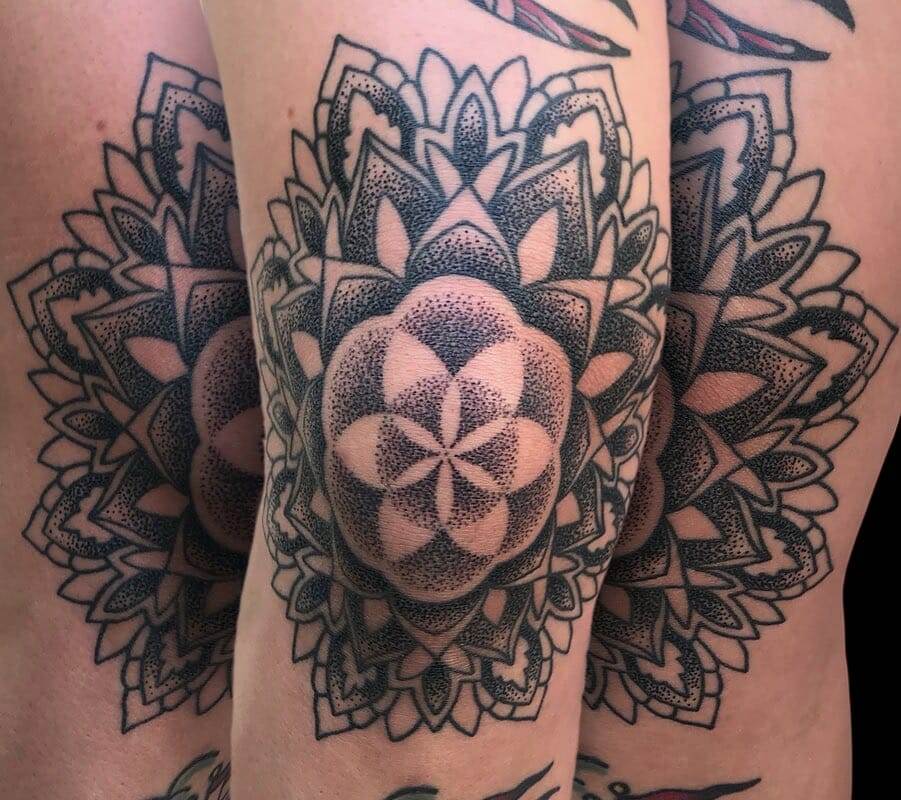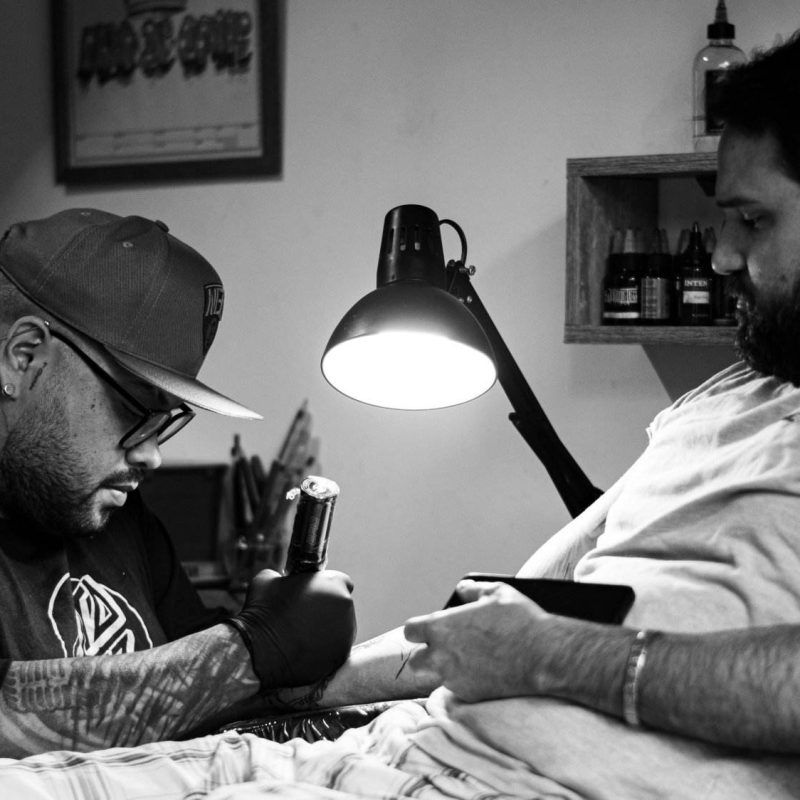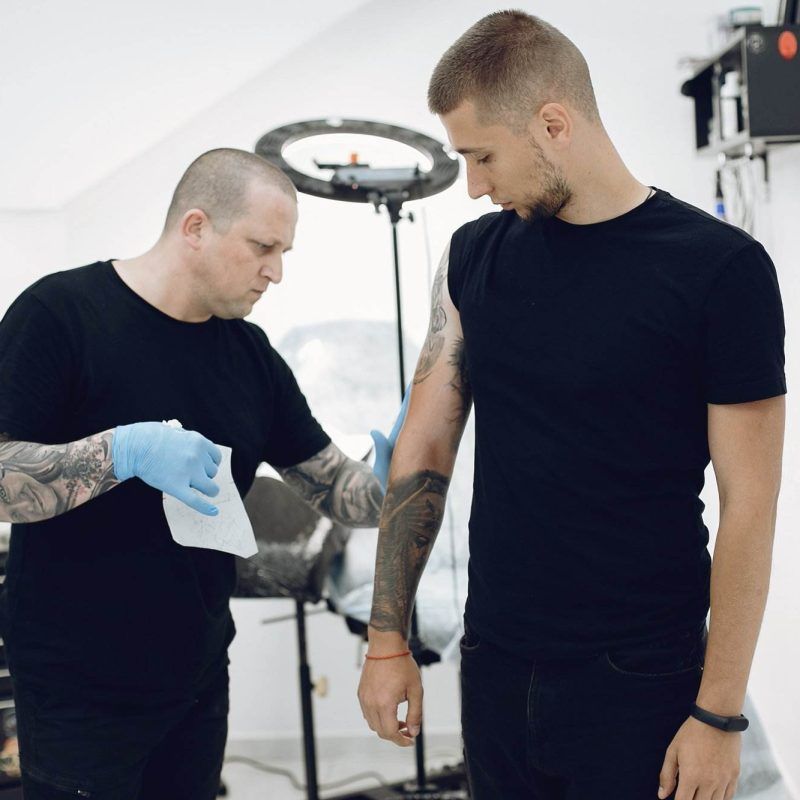Introduction
Understanding Large Tattoo Pieces
Large tattoo pieces are an exciting avenue for self-expression, allowing individuals to transform their skin into a canvas of art. These sizable tattoos often represent significant life experiences, personal philosophies, or artistic tributes. Given their visibility and permanence, it’s important to approach large tattoos with a thorough understanding and appreciation for the art form involved. Individuals often favor full sleeves, back pieces, or chest tattoos because of their ability to tell a comprehensive story. However, the intricate nature of these designs requires an artist skilled in not only drawing but also in executing large scale pieces across expanse skin surfaces.

Importance of Proper Planning
Planning is key in ensuring a fulfilling tattoo experience. Those looking to invest in large tattoos should consider the following essential steps:
- Research: Explore different designs and identify what resonates with you.
- Consultation: Schedule consultations with tattoo artists to discuss ideas and gather insights on feasible designs.
- Design Adaptation: Be open to adapting your initial concept. Artists may provide suggestions that enhance your vision based on their expertise.
The more preparation put into planning, the more rewarding the final outcome. Engaging in thoughtful dialogue and aligning expectations with the chosen tattoo artist can lead to a masterpiece that embodies personal significance while ensuring a comfortable and enjoyable experience throughout the process.
Choosing the Right Design
Factors to Consider
Selecting the right design for a large tattoo is a significant step that requires careful thought and personal reflection. The design should resonate deeply with your identity and aesthetic preferences. Here are some factors to consider when making your choice:
- Personal Meaning: Choose imagery or symbols that represent crucial aspects of your life, interests, or experiences.
- Style Preference: Familiarize yourself with different tattoo styles—traditional, watercolor, geometric, and realism are just a few. Finding a style you love will enhance your satisfaction with the final piece.
- Longevity: Think about how trends may change over time. Opt for timeless designs that you believe will hold their significance in the years to come.
By contemplating these factors, individuals can cultivate a design that not only looks beautiful but also stands the test of time.
Working with a Tattoo Artist
Collaborating with a skilled tattoo artist is paramount in bringing your vision to life. Here are a few key points to strengthen this partnership:
- Open Communication: Clearly articulate your ideas and inspirations. The more your artist understands your vision, the better they can translate it into a design.
- Feedback: Provide constructive feedback during the design process. This engagement helps refine the artwork and adds to the collaborative experience.
- Trust Their Expertise: Artists have valuable insights and can suggest adjustments that enhance the design’s impact and suitability for your body.
Ultimately, a harmonious relationship with your tattoo artist not only fosters a successful outcome but also makes the entire tattooing experience enjoyable. Engaging openly and valuing their creativity can lead to a stunning result that you will proudly display for years to come.
Placement and Sizing
Popular Placement Options
Once the design is finalized, the next significant step is deciding on where to place the tattoo, especially for larger pieces. The placement can dramatically affect both the aesthetic and visibility of the tattoo. Here are some popular options to consider:
- Full Sleeves: These are an excellent choice for individuals wishing to make a bold statement, as the entire arm can be adorned with intricate designs.
- Back Pieces: A full back tattoo allows for expansive artwork and the ability to incorporate extensive details. It also provides a great option for those seeking a more private piece.
- Chest Tattoos: This area offers a large canvas that can enhance the body’s natural contours, making it ideal for symmetrical designs.
Choosing the right placement can enhance the overall impact of the tattoo and its visibility in social situations.
Finding the Right Size
Along with placement, size is a crucial aspect of tattoo design that should not be overlooked. Here’s how to find the perfect size for your tattoo:
- Proportionality: Ensure the tattoo design is proportional to the body part where it will be placed. A design may lose its impact if too small or overcrowded when too large.
- Visibility Considerations: Think about how visible you want your tattoo to be. Larger tattoos can be stunning but may also invite more scrutiny.
- Comfort Level: Reflect on your comfort level with size. A large piece can be a more significant commitment, so choose a size that you will be comfortable displaying and living with every day.
By carefully considering both placement and sizing, individuals can ensure their large tattoo not only looks visually appealing but also aligns with personal preferences and lifestyle.
Tattoo Preparation
Preparing Your Skin
As the day for getting your large tattoo approaches, it’s essential to focus on prepping your skin. Healthy skin not only ensures a better tattoo but also enhances the healing process. Here are some effective ways to prepare your skin:
- Hydrate: Drink plenty of water in the days leading up to your appointment. Well-hydrated skin is more elastic and allows for easier tattooing.
- Moisturize: Apply a good quality moisturizer to the area you’ll be tattooing. This will help keep your skin soft and supple, providing a smoother canvas for your tattoo artist.
- Avoid Sun Exposure: Try to minimize tanning or sunburn on the area to be tattooed. Sunburned or damaged skin can hinder the tattooing process and affect the outcome.
Taking these steps can contribute significantly to the quality of your tattoo.
Mental Preparation Tips
Mental preparation is just as crucial as physical readiness. Getting a large tattoo can be an emotional journey, and being mentally prepared can make the experience smoother. Consider these tips:
- Visualize the Process: Imagine yourself sitting in the chair, what the experience will feel like, and the outcome you expect. This can help alleviate anxiety or discomfort on the day.
- Research Pain Management: Understanding the pain levels associated with tattooing can help set realistic expectations and reduce anxiety.
- Plan Ahead: Consider practicing relaxation techniques, such as deep breathing or meditation, to manage stress and stay calm during the session.
Approaching your tattoo appointment with a sense of mental clarity and readiness can enhance your overall experience, making it not just a procedure but a memorable milestone. By preparing both your skin and mind, you set the stage for a successful and fulfilling tattoo journey.

tattoo aftercare
Proper Healing Techniques
Once you’ve sat through the tattooing process and are ready to show off your new artwork, the focus shifts to aftercare. Proper healing techniques are vital to ensure the tattoo looks vibrant and lasts long. Here are some essential tips for effective aftercare:
- Keep it Clean: Gently wash the tattoo with mild soap and lukewarm water. Avoid scrubbing; instead, use your hands to clean the area.
- Moisturize: Apply a thin layer of fragrance-free lotion or an aftercare balm recommended by your artist to keep the tattoo hydrated and prevent excessive itching.
- Avoid Sun Exposure: Keep your tattoo out of direct sunlight and avoid soaking it in water, like pools or hot tubs, for at least two weeks.
These techniques will help prevent infections and fade, leading to a well-healed masterpiece.
Long-Term Care Tips
Once your tattoo has healed, maintaining its beauty becomes the next priority. Long-term care is essential to keep the colors vibrant and the design intact. Here’s how to do it:
- Moisturize Regularly: Keeping the skin hydrated not only improves its texture but also enhances the appearance of the tattoo.
- Sunscreen Application: Always apply sunscreen to the tattooed area when exposed to sunlight. UV rays can lead to fading and discoloration over time.
- Routine Check-ups: Consider checking in with your tattoo artist for periodic touch-ups to maintain the vibrancy, especially on larger pieces that may need more care.
By adopting these long-term care practices, individuals can ensure their tattoo continues to be a source of pride and joy for years to come. A commitment to proper aftercare transforms the tattoo from merely a design into a lifelong expression of art.
Dealing with Pain
Pain Management Strategies
Experiencing discomfort during the tattooing process is a common concern for many. Understanding pain management strategies can make the process much more manageable. Here are some effective techniques to alleviate pain during your session:
- Numbing Creams: Many tattoo studios offer topical numbing creams that can be applied before the procedure. Discuss this option with your artist in advance to see if it’s appropriate for your tattoo.
- Stay Relaxed: Tension can amplify pain perception. Practicing deep-breathing exercises or listening to calming music while getting tattooed can help maintain a relaxed state.
- Focused Distraction: Bring a book, a podcast, or a playlist of your favorite songs. Engaging your mind can make the pain feel more manageable.
By employing these techniques, individuals can make their tattoo experience significantly more comfortable.
Knowing Your Limits
Understanding and respecting your pain threshold is crucial when preparing for a tattoo. Everyone has different levels of tolerance, and it’s essential to recognize your own:
- Choose Wisely: If you know that large areas or certain parts of the body are more sensitive for you, consider starting with smaller pieces before committing to larger tattoos.
- Communicate with Your Artist: Before the session, discuss any concerns with your tattoo artist. They can suggest breaks or adjustments if you begin to feel overwhelmed.
- Listen to Your Body: If at any point the pain becomes unbearable, don’t hesitate to speak up. Your comfort should always be a priority.
Being aware of your limits allows for a smoother experience and a more enjoyable journey into the world of tattoos, ensuring that the art on your skin remains a source of pride rather than discomfort.
Budgeting for a Large Tattoo
Understanding Cost Factors
When embarking on the journey of getting a large tattoo, budgeting is a crucial aspect to consider. The cost of tattoos can vary significantly based on several factors, and understanding these can help you prepare financially:
- Size and Complexity: Larger tattoos with intricate designs typically take more time, resulting in higher costs. The level of detail involved greatly influences the final price.
- Artist Experience: Renowned artists with extensive portfolios often charge premium rates. While it may be tempting to opt for cheaper options, investing in a skilled artist can ensure a quality outcome.
- Location of the Studio: Prices can also vary between different studios. Urban areas may have higher costs due to the cost of living, while rural studios might offer more competitive pricing.
By considering these factors, individuals can gain a clearer picture of what to expect in terms of tattoo costs.
Setting a Realistic Budget
Once you have a better understanding of the cost factors, setting a realistic budget becomes essential. Here are some steps to help you establish one:
- Research Average Costs: Look for average prices for large tattoos in your area. This gives you a baseline to work from.
- Consider Additional Expenses: Don’t forget to factor in aftercare products, touch-ups, and tips for your artist. These additional expenses can add up, so it’s wise to include them in your budget.
- Save Ahead: If the tattoo you want is significant, consider saving up in advance. Setting aside a specific amount each month can help you reach your financial goal without feeling rushed.
By understanding the various cost factors and setting a comprehensive budget, individuals can ensure they embark on their tattoo journey without financial stress, ultimately leading to a more enjoyable experience.
Finding the Right Tattoo Studio
Researching Tattoo Studios
Finding the right tattoo studio is a critical step in ensuring a successful tattoo experience. Researching potential studios thoroughly can make a significant difference in the quality of the outcome. Start by exploring:
- Online Reviews and Ratings: Websites and platforms like Google, Yelp, and Instagram provide insights from previous clients. Look for studios with consistent positive feedback, particularly regarding large tattoos.
- Artist Portfolios: Most reputable studios showcase portfolios of their artists. Pay attention to their styles and whether they align with your vision for your tattoo.
- Hygiene and Safety Practices: Check if the studio maintains high cleanliness standards. Look for information regarding sterilization procedures and whether the artists follow health regulations.
By taking the time to research, individuals can narrow down their options effectively and find a studio that meets their expectations.
Questions to Ask Before Booking
Before finalizing your decision, it’s essential to ask specific questions that will help clarify any concerns:
- Experience with Large Tattoos: Inquire about the artist’s experience with large pieces similar to your design. This ensures they have the necessary skills for your vision.
- Consultation Process: Ask about the consultation process and how designs are finalized. Open communication is crucial to a successful outcome.
- Pricing and Payment Plans: Clarify the pricing structure and any available payment plans, particularly for larger tattoos that may require multiple sessions.
By conducting thorough research and asking the right questions, individuals can confidently choose a tattoo studio that aligns with their desires and expectations. This thoughtful approach sets the stage for a rewarding tattooing experience that turns a vision into a breathtaking reality.
Communicating with Your Tattoo Artist
Articulating Your Vision
Effective communication with your tattoo artist is paramount to achieving the perfect tattoo. Articulating your vision clearly helps your artist understand precisely what you want. Here are some techniques to ensure your ideas are communicated effectively:
- Visual References: Bring along images that inspire your desired design. This can include tattoos you admire, artwork, or color palettes. Visual aids provide a reference point that can bridge gaps in understanding.
- Be Descriptive: Explain the meaning behind your tattoo design. Sharing personal stories or what the imagery signifies to you can help the artist capture that essence in their work.
- Discuss Preferences: Talk about your style preferences—do you lean towards traditional, modern, or a specific motif? The more detail you provide, the clearer your vision becomes.
By conveying your ideas thoughtfully, you set the foundation for a successful tattoo process.
Providing Feedback Effectively
Once the artist presents your design, providing constructive feedback is crucial. Here are some pointers on how to communicate your thoughts effectively:
- Focus on Specifics: If something doesn’t quite match your expectations, pinpoint the exact elements. For instance, “Could we adjust the color saturation?” or “I’d like to see the proportions altered slightly.”
- Stay Positive: Appreciate the artist’s efforts while offering suggestions. Positive reinforcement encourages collaboration and helps maintain a supportive atmosphere.
- Be Open to Adjustments: Remember, artists are professionals with a wealth of experience. They may suggest changes or enhancements that can elevate the design.
By engaging in open, honest dialogue, and providing constructive feedback, clients can foster a collaborative relationship with their tattoo artist, ultimately leading to a tattoo that feels truly personal and exceptional.
Final Touches and Touch-Ups

Assessing the Final Result
After the tattooing process is complete, it’s time to take a step back and assess the final result. This moment can be incredibly rewarding, but it’s also important to ensure that everything meets your expectations. Here are some tips for evaluating your new ink:
- Check for Details: Examine the design closely and ensure all elements are as intended. Look out for any inconsistencies or areas where the ink might not have settled properly.
- Evaluate Color and Line Work: Observe the vibrancy of colors and the sharpness of lines. High-quality tattoos should have bold outlines and well-defined shades.
- Discuss with Your Artist: Sit down with your artist and share your thoughts. They can provide insights into what to expect during the healing process and whether any adjustments may be necessary.
Being proactive in this stage helps in appreciating your art while ensuring that any potential issues are addressed early.
Scheduling Touch-Up Sessions
Regardless of the careful planning and execution, touch-ups are often a natural part of the tattoo lifecycle. Scheduling these sessions is vital for maintaining the aesthetic appeal of your tattoo. Here’s how to approach it:
- Timing is Key: Most artists recommend waiting about 4-6 weeks after the initial session for any touch-ups once the tattoo has healed. This allows any swelling or scabbing to subside.
- Communicate with Your Artist: Connect with your tattoo artist and discuss if touch-ups are necessary. They will guide you based on their assessment of your tattoo’s healing process.
- Consider a Touch-Up Service: Some studios offer free or discounted touch-up sessions within a certain timeframe, so be sure to inquire about this benefit.
By assessing the final result and being proactive about touch-ups, individuals can ensure their large tattoos remain vibrant and visually stunning for years to come. Ultimately, this level of commitment reflects the care and appreciation for the art that adorns their skin.
